All three living elephant species are threatened; both the African bush elephant and the Asian elephant are endangered, while the African forest elephant is critically endangered. The populations of endangered elephants in both Africa and Asia are decreasing and becoming ever-more fragmented.
On this page, we cover all three endangered elephants and the threats they currently face.
Page Index
- Introduction To Elephants
- Poaching
- Ivory
- Habitat Loss
- Africa’s Elephants
- African Bush Elephant
- African Forest Elephant
- Asian Elephant
- Further Reading
Introduction To Elephants
Despite being among the most recognizable animals on Earth, elephants are under threat. These iconic animals, known not only for their distinctive appearance, but also for their high intelligence and fabled long memories, face an uncertain future. Wild elephant populations have fallen by 62% in the last decade (source) and extinction is an ever-growing possibility.
Three living species of elephant are recognized: the African bush elephant, African forest elephant, and Asian elephant.
Together, they make up the family Elephantidae, which also includes several extinct species, including the mammoths. (Mastodons, although related, belong to a different family: Mammutidae.)
All three living elephant species appear on the IUCN red list of threatened species.
(IUCN = International Union for Conservation of Nature)
The two main threats to elephants are poaching and habitat loss.
Elephant Poaching
Elephants are targeted by poachers primarily for their ivory tusks, which are traded by criminal networks and fetch high prices on the black market.
Ivory
Ivory is a hard, white substance obtained from the tusks and teeth of animals, most notably from the tusks of elephants – the word “ivory” is derived from the ancient Egyptian word for “elephant”.
Ivory has been traded by humans for over 3,500 years. Historically, the ivory trade was extremely important for the continent of Africa; Ivory Coast (also known as Côte d'Ivoire), a country in Western Africa, was named after the material.
Being durable, relatively easy to work on, and pleasing to the eye, ivory was used in the manufacture of a variety of items, including knife handles, billiard balls, piano keys, pipes, and a variety of ornamental objects.
The ivory trade has been responsible for a huge reduction in the populations of all three elephant species. In the 1980’s, half of Africa’s 1.3 million elephants were killed to supply the ivory trade.
In 1989, a CITES ruling placed a worldwide ban on the trade of African elephant ivory. Despite this, and several other subsequent rulings prohibiting the sale of ivory, elephants continue to be hunted to supply the illegal ivory trade.
(CITES = Convention on International Trade in Endangered Species of Wild Fauna and Flora)
Habitat Loss
While poaching is the primary threat to Africa’s elephants (although habitat loss is a close second), in Asia the situation is reversed.
The human populations of both Africa and Asia have undergone huge growth in recent years. This has resulted in a vast amount of savannas and forests – the traditional homes of most elephants – being destroyed to make way for growing cities, towns, farms, plantations, roads, and other human developments.
Elephants are being forced into areas too small to support large elephant populations. Additionally, elephant populations are becoming increasingly fragmented, leaving them at risk of disease and genetic problems.
Human-Elephant Conflict
Habitat loss also increases the likelihood of conflict between humans and elephants. Although elephants are herbivores, they are large, powerful animals that need a lot of space.
Not only are elephants a danger to crops, they are also dangerous to humans, killing several hundred people every year. As a result, elephants may be seen by many people in local communities as a threat both to their livelihoods and to their safety; just one of the many challenges faced by conservationists.
Africa’s Elephants
Africa is home to two species of elephant: the African bush elephant and the African forest elephant. Both belong to the genus Loxodonta, and until recently these closely-related species were considered to be subspecies of a single African elephant species.
African elephants are distributed across a wide area of sub-Saharan Africa.
African Bush Elephant / African Savanna Elephant
- Scientific name: Loxodonta africana
- Conservation status: Endangered
- Height (male): 3.04 to 3.36 m / 9.97 to 11.02 ft.
- Height (female): 2.47 to 2.73 m / 8.1 to 8.96 ft.
- Weight (male): 5.2 to 6.9 t / 5.73 to 7.6 short tons
- Weight (female): 2.6 to 3.5 t / 2.87 to 3.86 short tons
The African bush elephant (also known as the African savanna elephant) is famous for being the world’s largest and heaviest living land animal.
The average weight of a male African bush elephant is around 6 metric tons / 6.61 short tons – that’s over 4 times the weight of a typical hatchback car. Females are around 50% of the weight of males.
The largest-known African bush elephant had an estimated weight of over 10 tons / 11.02 short tons.
The African bush elephant inhabits a range of habitats, including forests, woodlands and deserts, but is typically found in savannas and open plains. Females live in herds with their offspring. Males, after reaching maturity, are more independent, living alone or in small bachelor groups.
Unlike the Asian elephant, both male and female African bush elephants have tusks (in general, only male Asian elephants have tusks).
The population of African elephants (both bush and forest species) is around 415,000 individuals; half of what it was in the 1930’s. Despite numerous conservation schemes, the species’ population continues to decline.
Even today, the main threat to the African bush elephant is poaching for the ivory trade.
Habitat loss is also a major factor in the species’ continued decline; as Africa’s human population continues to rise, more and more of the elephant’s traditional habitat is lost due to the planting of crops, the growth of towns and cities, and the construction of roads and other infrastructure.
African Forest Elephant
- Scientific name: Loxodonta cyclotis
- Conservation status: Critically Endangered
- Height (male): 2.09 to 2.31 m / 6.86 to 7.58 ft.
- Height (female): 1.8 to 2.4 m / 5.91 to 7.87 ft.
- Weight (male): 1.7 to 2.3 t / 1.87 to 2.53 short tons
- Weight (female): 1.5 to 1.9 t / 1.65 to 2.09 short tons
The African forest elephant, which until the turn of the 21st century was considered a subspecies of African elephant, is the smallest of the three elephant species.
As its name suggests, the African forest elephant is found in forest habitats. It is present in tropical forests and other forest habitats in western and central Africa. The largest remaining populations of forest elephants are found in Gabon and the Republic of the Congo.
Fruit forms a major part of the diet of forest elephants. The species also eats bark and leaves from trees.
The African forest elephant plays an important part in the ecosystem of African forests as its fruit-based diet helps distribute seeds (the dung of African forest elephants often contains the seeds of over 70 species of trees).
The main threat to this endangered elephant is illegal poaching. Deforestation is also a significant threat to the species, whose population is becoming ever-more fragmented as its forest habitat is lost.
Asian Elephant
- Scientific name: Elephas maximus
- Conservation status: Endangered
- Height (male): 2.61 to 2.89 m / 8.56 to 9.48 ft.
- Height (female): 2.28 to 2.52 m / 7.48 to 8.27 ft.
- Weight (male): 3.5 to 4.6 t / 3.86 to 5.07 short tons
- Weight (female): 2.3 to 3.1 t / 2.53 to 3.42 short tons
With an average weight lower than that of the African bush elephant, and higher than that of the white rhinoceros, the Asian elephant is the world’s second-largest land animal (and the largest found in Asia).
Apart from size, differences between the Asian and African elephants include: smaller ears, a back that is generally convex rather than concave, and smoother skin.
Unlike their African cousins, female Asian elephants rarely have tusks. As a result, males are more likely to be targeted by poachers.
Asian elephants are additionally targeted for their skin, which is used for a variety of products, including beads for jewelry.
The black market trade in both elephants and ivory is particularly active in Thailand.
Asian elephant calves are also stolen and smuggled out of their native countries to Thailand, where they are trained (often with brutal methods) and used in the tourist industry.
Although poaching remains a serious problem, the biggest threat faced by the Asian elephant is habitat loss and fragmentation.
Logging, the creation of crop plantations, the growth of towns and cities, and the construction of infrastructure such as roads, railways and power lines all result in the destruction of the elephant’s traditional habitat.
The rapid growth of Asia’s human population brings humans and elephants into conflict. Not only are elephants responsible for the destruction of millions of dollars’ worth of crops each year, but these large, dangerous animals also cause the deaths of hundreds of people.
This is a tragic result of humans and elephants having to share an ever-decreasing amount of space.
The total Asian elephant population consists of around 40-50,000 individuals, around 60% of which live in India (source); many sport stadiums hold more people than there are Asian elephants left in the wild. The Asian elephant population has declined by at least 50% in three generations (source).
Elephant Extinction
With decreasing, ever-more fragmented, elephant populations, the threat of extinction is very real for these distinctive animals.
It can take many years for elephant populations to rise significantly; female elephants are usually at least nine years old before they start to breed; males well into their teens.
With gestation lasting around two years (among the longest pregnancies of all mammals), and several years between each birth, the typical generation length is around 25 and 22 years for African bush and Asian elephants respectively.
If we want to save these magnificent animals, we need to act immediately.
Further Reading
You can find out more about elephants and other endangered animals on the following pages:

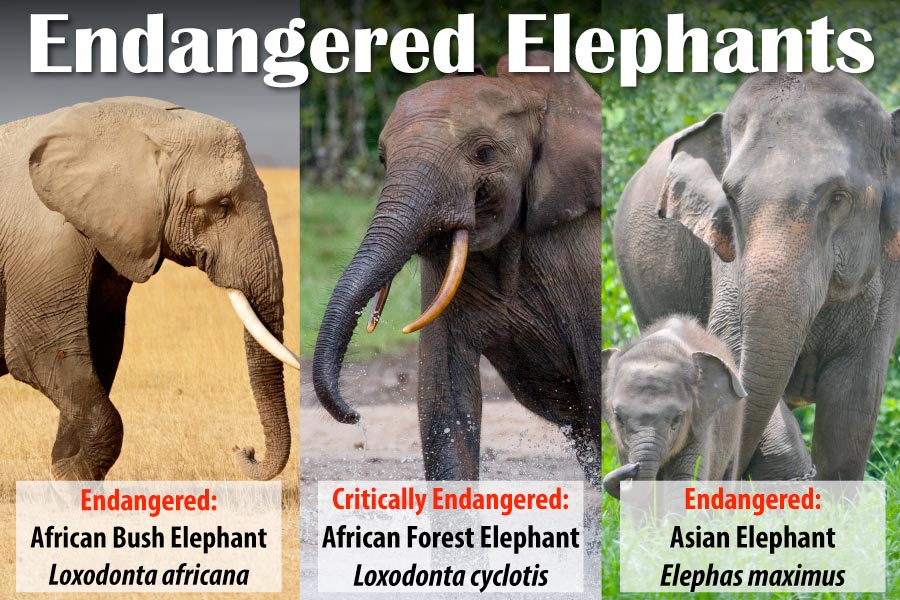
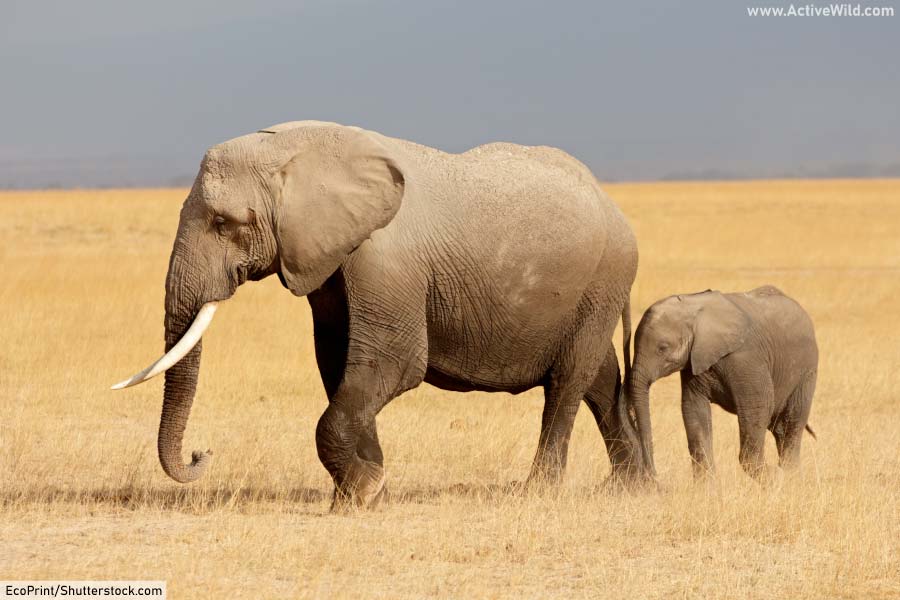
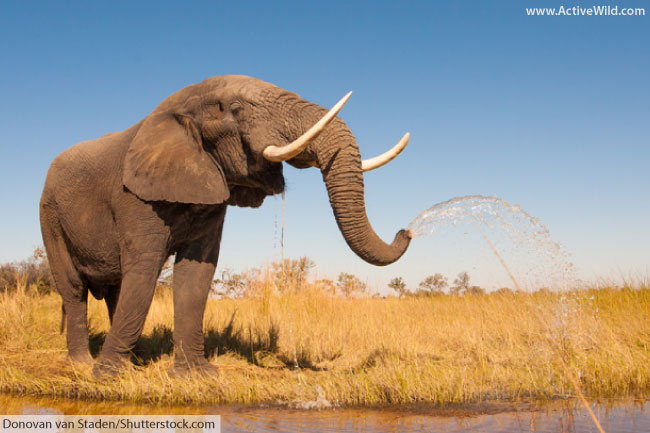
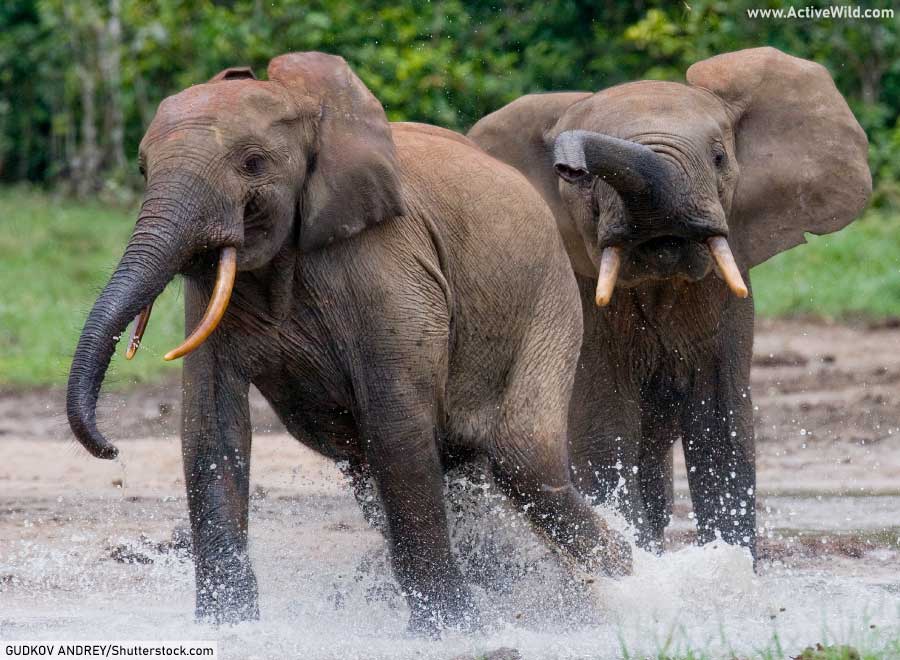
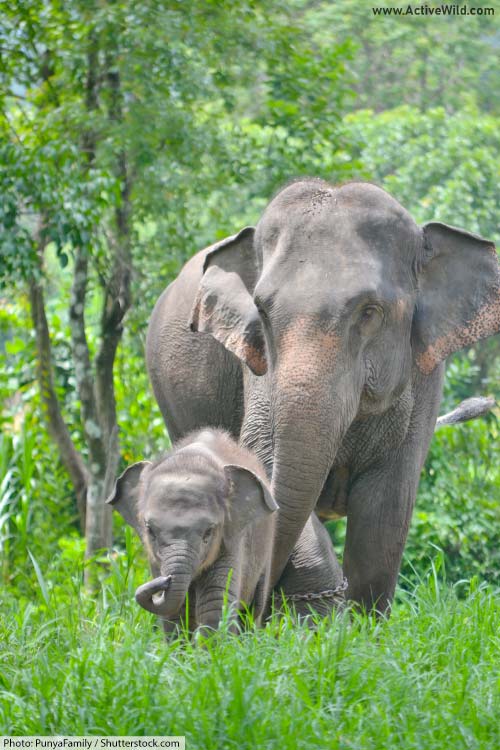

Thank you so much I was doing a test and this was very helpful than you so much.
You’re welcome! 🙂